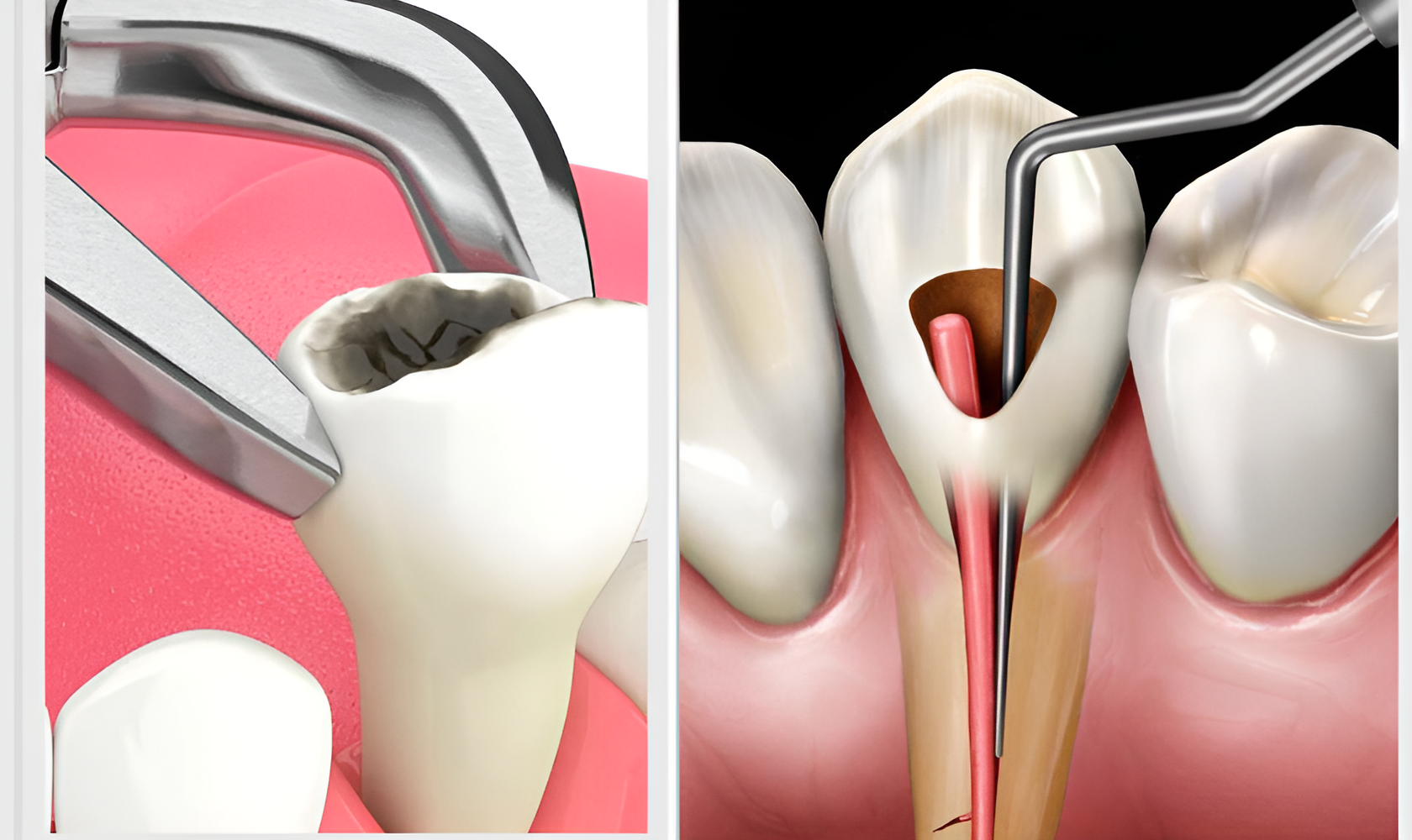
Table Of Contents
- Introduction
- Understanding the Basics of Root Canal and Tooth Extraction
- Conditions That Lead to Root Canal vs. Tooth Extraction
- Procedure Comparison: Root Canal vs. Tooth Extraction
- Pain and Recovery: Which is More Painful?
- Costs and Insurance Coverage: Financial Considerations
- Long-Term Effects: Preserving Oral Health
- Alternatives to Root Canals and Extractions
- Which Procedure is Right for You? Factors to Consider
- Choosing the Best Option for Your Oral Health
- Frequently Asked Questions (FAQs)
Introduction
When you’re experiencing severe tooth pain, decay, or infection, you’re likely faced with two common treatment options: a root canal or tooth extraction. Understanding the difference between root canals and tooth extractions is vital to making an informed decision about which procedure is right for you. Both treatments serve distinct purposes, and the right choice depends on the condition of your tooth and your long-term dental health goals. In this article, we’ll explore both procedures in depth, comparing their benefits, drawbacks, and how they impact your oral health.
Understanding the Basics of Root Canal and Tooth Extraction
Before making a decision, it’s important to understand what each procedure entails and what it aims to achieve.
What is a Root Canal?
A root canal is a dental procedure designed to save a tooth that is badly decayed or infected. It involves removing the infected or damaged pulp inside the tooth, cleaning the root canals, and then sealing the tooth to prevent further infection. A root canal allows you to preserve your natural tooth, avoiding extraction, while alleviating pain and preventing the spread of infection.
What is a Tooth Extraction?
Tooth extraction involves the complete removal of a tooth from its socket in the bone. It is usually recommended when a tooth is severely damaged, decayed beyond repair, or poses a threat to surrounding teeth. Extractions may be performed due to advanced gum disease, impacted wisdom teeth, or for orthodontic reasons.
Conditions That Lead to Root Canal vs. Tooth Extraction
Your dentist will recommend a root canal or extraction based on the severity of damage to your tooth and surrounding tissue.
When is a Root Canal Recommended?
Root canals are typically recommended when the soft tissue (pulp) inside the tooth becomes infected due to deep decay, cracks, or repeated dental procedures. Signs that you may need a root canal include persistent toothache, sensitivity to hot or cold, and swollen or tender gums. The procedure is designed to relieve pain while preserving your natural tooth.
When is Tooth Extraction Necessary?
Tooth extraction is necessary when a tooth is too damaged to be saved or poses a risk to neighboring teeth. Severe decay, trauma, and periodontal disease may leave a tooth unsalvageable. Wisdom teeth, which often become impacted, are also frequently extracted. Additionally, extractions may be needed to resolve crowding issues for orthodontic treatment.
Procedure Comparison: Root Canal vs. Tooth Extraction
Let’s walk through the steps of each procedure to better understand how they differ in practice.
Step-by-Step Guide to a Root Canal Procedure
- Numbing the Area: The dentist administers local anesthesia to numb the area, ensuring you don’t feel pain.
- Removing the Infected Pulp: A small opening is made in the tooth to access the infected or dead pulp, which is then carefully removed.
- Cleaning the Canals: The dentist cleans and disinfects the tooth’s root canals to eliminate bacteria and prevent future infection.
- Sealing the Tooth: The canals are filled with a biocompatible material, and the tooth is sealed. In many cases, a crown is placed to strengthen the tooth and restore its function.
Step-by-Step Guide to Tooth Extraction
- Numbing the Area: As with a root canal, local anesthesia is applied to numb the affected area.
- Loosening the Tooth: The dentist uses specialized instruments to loosen the tooth from its socket.
- Removing the Tooth: The tooth is carefully removed, and if necessary, the area is stitched to promote healing.
- Post-Extraction Care: Gauze is placed over the extraction site to control bleeding, and you’ll be given instructions for at-home care.
Pain and Recovery: Which is More Painful?
Pain is a primary concern for most patients, so understanding what to expect during and after each procedure can help ease your mind.
Pain Levels During and After a Root Canal
Thanks to advancements in dental technology and anesthesia, root canals are now relatively painless procedures. During the procedure, local anesthesia ensures that you feel no pain, though you may feel slight pressure. Post-procedure, some mild discomfort and tenderness are common, but this can typically be managed with over-the-counter pain relievers.
Pain Levels During and After Tooth Extraction
Tooth extractions, particularly simple ones, are also relatively painless thanks to anesthesia. However, surgical extractions may result in more discomfort due to the complexity of the procedure. Recovery from extractions generally takes longer than root canals, and you may experience swelling, soreness, and bleeding for a few days. The risk of dry socket, where the blood clot is dislodged from the extraction site, is a complication that can cause significant pain.
Costs and Insurance Coverage: Financial Considerations
Dental procedures can vary in cost depending on several factors, including the complexity of the procedure and your location.
Root Canal Costs
Root canals tend to be more expensive due to the intricate nature of the procedure and the potential need for a dental crown afterward. Many dental insurance plans cover part or all of the cost of a root canal, especially if it’s deemed medically necessary.
Tooth Extraction Costs
Tooth extractions are generally less expensive than root canals, particularly if it’s a simple extraction. However, you should also factor in potential replacement costs for missing teeth, such as dental implants, which can significantly increase the overall expense. Most insurance plans cover extractions.
Long-Term Effects: Preserving Oral Health
When deciding between a root canal and extraction, it’s crucial to consider the long-term impact on your dental health.
Benefits of Saving the Tooth with a Root Canal
A major benefit of root canals is that they preserve your natural tooth. Keeping the tooth intact helps maintain proper bite alignment, prevents adjacent teeth from shifting, and preserves bone density in the jaw. Teeth that undergo root canals, particularly when crowned, can last for many years, offering a durable solution that preserves both function and aesthetics.
Consequences of Tooth Extraction
While extractions may resolve immediate issues, they come with potential long-term drawbacks. When a tooth is removed, it leaves a gap that can cause neighboring teeth to shift, leading to misalignment. Additionally, the absence of the tooth can result in bone loss in the jaw over time, potentially altering the structure of your face. To avoid these issues, many patients opt for tooth replacements, such as dental implants, bridges, or dentures.
Alternatives to Root Canals and Extractions
In some cases, patients may explore other options before committing to a root canal or extraction.
Can a Tooth Be Saved Without a Root Canal?
In certain situations, more conservative treatments such as pulp capping or fillings may be recommended if the tooth’s pulp is not severely infected. However, when the pulp is significantly damaged, a root canal is typically the best option for saving the tooth.
Alternative Treatments After Extraction
Once a tooth is extracted, there are several options for replacing it. Dental implants are often the most durable and natural-looking option, though they can be costly. Bridges and dentures are other alternatives that restore function and aesthetics. Each replacement option comes with its own set of pros and cons, so it’s important to discuss these with your dentist.
Which Procedure is Right for You? Factors to Consider
Several factors will influence whether a root canal or extraction is the better option for you.
Oral Health Factors
Your dentist will evaluate the extent of decay or damage to your tooth and recommend the best treatment accordingly. Root canals are generally preferred for preserving the natural tooth whenever possible, while extractions are a last resort when the tooth is beyond repair or poses a risk to your overall dental health.
Personal and Financial Preferences
While oral health is the primary consideration, personal preferences, and financial factors also play a role. Some patients prefer the idea of removing a damaged tooth entirely, while others prioritize keeping their natural teeth. Additionally, the cost of each procedure and what your insurance covers will likely influence your decision.
Choosing the Best Option for Your Oral Health
Whether you opt for a root canal or a tooth extraction, the best choice ultimately depends on the condition of your tooth, your long-term dental health goals, and your dentist’s recommendation. By understanding the difference between root canals and tooth extractions, you can make an informed decision that aligns with your oral health needs.
Frequently Asked Questions (FAQs)
1. Is a root canal more painful than a tooth extraction?
Root canals and tooth extractions are performed under local anesthesia, making both procedures relatively painless. However, recovery from a tooth extraction, especially a surgical one, may involve more discomfort than a root canal.
2. How long does recovery take after a root canal or tooth extraction?
Recovery from a root canal typically takes a few days, with most patients able to resume normal activities soon after the procedure. Recovery from a tooth extraction may take a week or longer, especially if it’s a surgical extraction.
3. Can I replace a tooth after extraction?
Yes, after a tooth extraction, you can replace the missing tooth with dental implants, bridges, or dentures. Dental implants are the most permanent and durable option, but they can be costly.
4. Will my dental insurance cover a root canal or extraction?
Most dental insurance plans cover part or all of the cost of both root canals and extractions. It’s important to check with your provider to understand your coverage and any out-of-pocket costs.
5. Is it better to save a tooth or extract it?
In most cases, saving your natural tooth with a root canal is the preferred option because it preserves your bite and helps maintain jawbone density. However, if the tooth is too damaged to be saved, extraction may be necessary.













